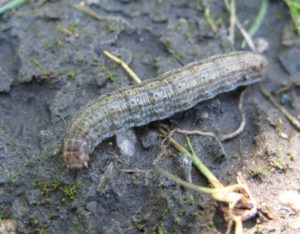Insect of the Week: Darksided Cutworm
Darksided Cutworm
Euxoa messoria
Week 2 (May 14) Darksided cutworm 
Identification
adults: Forewings grayish, each with an oval and a kidney-shaped paler spot with darker margins among irregular dark lines. Wingspan of about 35 mm. mature larvae: Hairless, up to 37 mm in length. Grayish in color with a prominent white stripe along each side just above the legs; upper surface with a reddish background color. Head is orange-brown with darker spots.
Distribution
Native to North America. Distributed from Atlantic to Pacific coasts, north from the southern USA into southern Canada.Lifecycle
Females lay up to 1000 eggs in soil or under debris in cultivated fields. Mature larvae enter a non-feeding pre-pupal stage for about 30 days before pupating. One generation per year.
Hosts
Broad range of herbaceous and woody hosts including vegetables, cereals, canola, corn, tobacco, flax, sunflower, vine, berry and tree fruits.

Feeding damage
above-ground (climbing) cutworm: Larvae feed at night on the leaves and stems of young plants causing defoliation
and death. Areas of bare soil increasing in size soon after crop emergence may indicate cutworm feeding damage.
Monitoring/Control
Inspect bare patches and surrounding margins for larvae, which hide at the base of plants during the day. Count the number of larvae in a 50 cm x 50 cm area of the crop; multiply by four to estimate the number of larvae per m2. Repeat this process 5 to 10 times at 50 m intervals.
Insecticide treatments may be warranted if economic thresholds are exceeded, but take steps to minimize effects on natural enemies; see
General Control Options (p. 26).
Economic threshold
cereal and oilseed crops: 5-6 larvae/ m2 (Phillip 2015).
peas: 2-3 larvae/m2.
dry beans and soybeans: 1 small (<2.5 cm long) larva/m of row or 20% of plants cut.
Notes
Larvae are similar in color to redbacked cutworm. The most destructive pest of tobacco throughout most tobacco growing regions of Canada (Cheng 1984). Can be particularly damaging to buds of trees and shrubs (Walkden 1950).